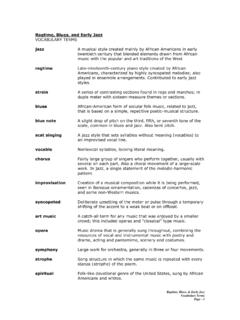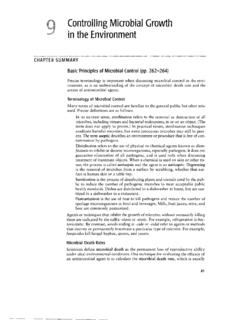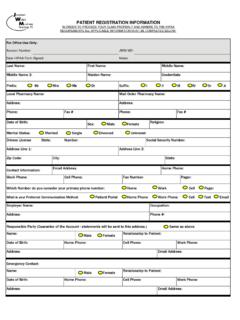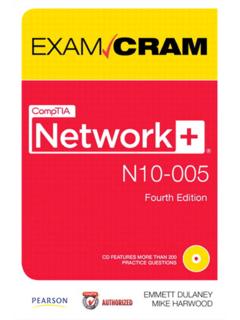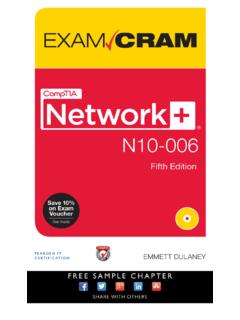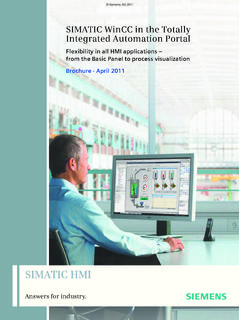Transcription of The OSI Model: Understanding the Seven Layers of …
1 The OSI Model: Understanding theSeven Layers ofComputer Reference Series of White PapersIntroductionThe Open Systems Interconnection (OSI) model is a reference tool for Understanding data communicationsbetween any two networked systems. It divides the communications processes into Seven Layers . Each layerboth performs specific functions to support the Layers above it and offers services to the Layers below it. Thethree lowest Layers focus on passing traffic through the network to an end system. The top four Layers comeinto play in the end system to complete the white paper will provide you with an Understanding of each of the Seven Layers , including their functionsand their relationships to each other. This will provide you with an overview of the network process, whichcan then act as a framework for Understanding the details of computer the discussion of networking often includes talk of extra Layers ,this paper will address these unofficiallayers as , this paper will draw comparisons between the theoretical OSI model and the functional TCP/IP TCP/IP has been used for network communications before the adoption of the OSI model , it supportsthe same functions and features in a differently layered Overview of the OSI model Paul Simoneau, Global Knowledge Course Director, Network+, CCNA, CTPThe OSI model : Understanding theSeven Layers of Computer NetworksCopyright 2006 Global Knowledge Training LLC.
2 All rights model offers a generic means to separate computer networking functions into multiple of these Layers relies on the Layers below it to provide supporting capabilities and performs support tothe Layers above it. Such a model of layered functionality is also called a protocol stack or protocol suite .Protocols, or rules, can do their work in either hardware or software or, as with most protocol stacks, in a com-bination of the two. The nature of these stacks is that the lower Layers do their work in hardware or firmware(software that runs on specific hardware chips) while the higher Layers work in Open System Interconnection model is a Seven -layer structure that specifies the requirements for commu-nications between two computers. The ISO (International Organization for Standardization) standard 7498-1defined this model . This model allows all network elements to operate together, no matter who created theprotocols and what computer vendor supports main benefits of the OSI model include the following: Helps users understand the big picture of networking Helps users understand how hardware and software elements function together Makes troubleshooting easier by separating networks into manageable pieces Defines terms that networking professionals can use to compare basic functional relationships on differ-ent networks Helps users understand new technologies as they are developed Aids in interpreting vendor explanations of product functionalityLayer 1 The Physical LayerThe physical layer of the OSI model defines connector and interface specifications, as well as the medium(cable) requirements.
3 Electrical, mechanical, functional, and procedural specifications are provided for sendinga bit stream on a computer 2006 Global Knowledge Training LLC. All rights 3 Components of the physical layer include: Cabling system components Adapters that connect media to physical interfaces Connector design and pin assignments Hub, repeater, and patch panel specifications Wireless system components Parallel SCSI (Small Computer System Interface) Network Interface Card (NIC)In a LAN environment, Category 5e UTP (Unshielded Twisted Pair) cable is generally used for the physical layerfor individual device connections. Fiber optic cabling is often used for the physical layer in a vertical or riserbackbone link. The IEEE, EIA/TIA, ANSI, and other similar standards bodies developed standards for this :The Physical Layer of the OSI model is only part of a LAN (Local Area Network).
4 Layer 2 The Data Link LayerLayer 2 of the OSI model provides the following functions: Allows a device to access the network to send and receive messages Offers a physical address so a device s data can be sent on the network Works with a device s networking software when sending and receiving messages Provides error-detection capabilityCommon networking components that function at layer 2 include: Network interface cards Ethernet and Token Ring switches BridgesNICs have a layer 2 or MAC address. A switch uses this address to filter and forward traffic, helping relievecongestion and collisions on a network 2006 Global Knowledge Training LLC. All rights and switches function in a similar fashion; however, bridging is normally a software program on a CPU,while switches use Application-Specific Integrated Circuits (ASICs) to perform the task in dedicated hardware,which is much 3 The Network LayerLayer 3, the network layer of the OSI model , provides an end-to-end logical addressing system so that a packetof data can be routed across several layer 2 networks (Ethernet, Token Ring, Frame Relay, etc.)
5 Note that net-work layer addresses can also be referred to as logical , software manufacturers, such as Novell, developed proprietary layer 3 addressing. However, the net-working industry has evolved to the point that it requires a common layer 3 addressing InternetProtocol (IP) addresses make networks easier to both set up and connect with one Internet usesIP addressing to provide connectivity to millions of networks around the make it easier to manage the network and control the flow of packets, many organizations separate theirnetwork layer addressing into smaller parts known as use the network or subnet portion ofthe IP addressing to route traffic between different networks. Each router must be configured specifically forthe networks or subnets that will be connected to its communicate with one another using routing protocols, such as Routing Information Protocol (RIP)and Open version of Shortest Path First (OSPF), to learn of other networks that are present and to calculate thebest way to reach each network based on a variety of criteria (such as the path with the fewest routers).
6 Routers and other networked systems make these routing decisions at the network passing packets between different networks, it may become necessary to adjust their outbound size toone that is compatible with the layer 2 protocol that is being used. The network layer accomplishes this via aprocess known as fragmentation. A router s network layer is usually responsible for doing the reassembly of fragmented packets happens at the network layer of the final destination 2006 Global Knowledge Training LLC. All rights of the additional functions of the network layer are diagnostics and the reporting of logical variations innormal network operation. While the network layer diagnostics may be initiated by any networked system, thesystem discovering the variation reports it to the original sender of the packet that is found to be outside nor-mal network variation reporting exception is content validation calculations.
7 If the calculation done by the receiving sys-tem does not match the value sent by the originating system, the receiver discards the related packet with noreport to the sender. Retransmission is left to a higher layer s basic security functionality can also be set up by filtering traffic using layer 3 addressing on routers orother similar 4 The Transport LayerLayer 4,the transport layer of the OSI model ,offers end-to-end communication between end devices through anetwork. Depending on the application, the transport layer either offers reliable, connection-oriented or con-nectionless, best-effort of the functions offered by the transport layer include: Application identification Client-side entity identification Confirmation that the entire message arrived intact Segmentation of data for network transport Control of data flow to prevent memory overruns Establishment and maintenance of both ends of virtual circuits Transmission-error detection Realignment of segmented data in the correct order on the receiving side Multiplexing or sharing of multiple sessions over a single physical linkThe most common transport layer protocols are the connection-oriented TCP Transmission Control Protocol(TCP) and the connectionless UDP User Datagram Protocol (UDP).
8 Copyright 2006 Global Knowledge Training LLC. All rights 5 The Session LayerLayer 5, the session layer, provides various services, including tracking the number of bytes that each end ofthe session has acknowledged receiving from the other end of the session layer allows applica-tions functioning on devices to establish,manage, and terminate a dialog through a network. Session layerfunctionality includes: Virtual connection between application entities Synchronization of data flow Creation of dialog units Connection parameter negotiations Partitioning of services into functional groups Acknowledgements of data received during a session Retransmission of data if it is not received by a deviceLayer 6 The Presentation LayerCopyright 2006 Global Knowledge Training LLC. All rights 6, the presentation layer, is responsible for how an application formats the data to be sent out onto thenetwork.
9 The presentation layer basically allows an application to read (or understand) the of presentation layer functionality include: Encryption and decryption of a message for security Compression and expansion of a message so that it travels efficiently Graphics formatting Content translation System-specific translationLayer 7 The Application LayerLayer 7, the application layer, provides an interface for the end user operating a device connected to a layer is what the user sees, in terms of loading an application (such as Web browser or e-mail); thatis, this application layer is the data the user views while using these of application layer functionality include: Support for file transfers Ability to print on a network Electronic mail Electronic messaging Browsing the World Wide WebLayers 8, 9, and 10 Whether a designed to be a humorous extension or a secret technician code, Layers 8, 9, and 10 are not offi-cially part of the OSI refer to the non-technical aspects of computer networking that often inter-fere with the smooth design and operation of the 8 is usually considered the office politics layer.
10 In most organizations, there is at least one group whois favored, at least temporarily, by management and receives special treatment. When it comes to network-ing, this may mean that this group always has the latest and/or fastest equipment and highest speed 2006 Global Knowledge Training LLC. All rights 9 is generally referred to as the blinders layer. This layer applies to organizational managers who havealready decided, usually with little or no current information, to dictate a previously successful network may say things such as: It worked in my last company, so we will use it here. Everybody says this is the right solution. I read in an airline magazine that this was the best way to do it so that is what we will do. What these managers seem to forget is that they are paying a highly qualified staff to provide them with use-ful information. These managers bypass planning in order to make a quick 10, the user layer, is in every organization.



